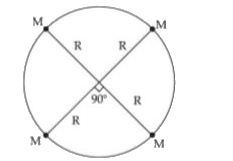Four particles of equal mass are moving round a circle of radius r due to their mutual gravitational attraction . Find the angular velocity of each particle .
The correct Answer is:
To find the angular velocity of each particle in a system of four equal mass particles moving in a circle due to their mutual gravitational attraction, we can follow these steps:
Step 1: Understand the System
We have four particles of equal mass m positioned at the corners of a square inscribed in a circle of radius r. Each particle experiences gravitational attraction from the other three particles.
Step 2: Calculate the Gravitational Force Between Particles
The gravitational force between any two particles is given by Newton's law of gravitation:
F=Gm2d2
where G is the gravitational constant and d is the distance between the two particles.
For two particles at the corners of the square, the distance d can be calculated using the Pythagorean theorem:
d=√(r)2+(r)2=r√2
Thus, the gravitational force between any two particles is:
F=Gm2(r√2)2=Gm22r2
Step 3: Resolve Forces Acting on Each Particle
Each particle experiences a net gravitational force due to the other three particles. The forces can be resolved into components. The angle between the line connecting the center of the circle to the particles and the line connecting two particles is 45∘.
The net force acting towards the center of the circle (centripetal force) can be expressed as:
Fnet=2Fcos(45∘)+F
Substituting the value of F:
Fnet=2(Gm22r2)1√2+Gm22r2
This simplifies to:
Fnet=Gm2r2(1√2+12)
Step 4: Apply Centripetal Force Condition
For circular motion, the net gravitational force must equal the centripetal force required to keep the particle in circular motion:
Fnet=mv2r
Setting the two expressions equal gives:
Gm2r2(1√2+12)=mv2r
Step 5: Solve for Velocity v
Rearranging the equation to solve for v2:
v2=Gmr(1√2+12)
Step 6: Calculate Angular Velocity ω
The angular velocity ω is related to linear velocity v by:
ω=vr
Substituting for v:
ω=1r
⎷Gmr(1√2+12)
Final Expression
Thus, the angular velocity ω of each particle is:
ω=
⎷Gmr2(1√2+12)
We have four particles of equal mass m positioned at the corners of a square inscribed in a circle of radius r. Each particle experiences gravitational attraction from the other three particles.
The gravitational force between any two particles is given by Newton's law of gravitation:
F=Gm2d2
where G is the gravitational constant and d is the distance between the two particles.
d=√(r)2+(r)2=r√2
Thus, the gravitational force between any two particles is:
F=Gm2(r√2)2=Gm22r2
Each particle experiences a net gravitational force due to the other three particles. The forces can be resolved into components. The angle between the line connecting the center of the circle to the particles and the line connecting two particles is 45∘.
Fnet=2Fcos(45∘)+F
Substituting the value of F:
Fnet=2(Gm22r2)1√2+Gm22r2
This simplifies to:
Fnet=Gm2r2(1√2+12)
For circular motion, the net gravitational force must equal the centripetal force required to keep the particle in circular motion:
Fnet=mv2r
Setting the two expressions equal gives:
Gm2r2(1√2+12)=mv2r
Rearranging the equation to solve for v2:
v2=Gmr(1√2+12)
The angular velocity ω is related to linear velocity v by:
ω=vr
Substituting for v:
ω=1r
⎷Gmr(1√2+12)
Thus, the angular velocity ω of each particle is:
ω=
⎷Gmr2(1√2+12)
Topper's Solved these Questions
- GRAVITATION BOOK - AAKASH INSTITUTECHAPTER - GRAVITATION EXERCISE - EXERCISE
20 Videos
- GRAVITATION BOOK - AAKASH INSTITUTECHAPTER - GRAVITATION EXERCISE - ASSIGNMENT SECTION - A (OBJECTIVE TYPE QUESTIONS)
49 Videos
- GRAVITATION BOOK - AAKASH INSTITUTECHAPTER - GRAVITATION EXERCISE - ASSIGNMENT SECTION -J (Aakash Challengers Questions)
6 Videos
- ELECTROSTATIC POTENTIAL AND CAPACITANCE BOOK - AAKASH INSTITUTECHAPTER - ELECTROSTATIC POTENTIAL AND CAPACITANCE EXERCISE - ASSIGNMENT SECTION - D
13 Videos
- KINETIC THEORYBOOK - AAKASH INSTITUTECHAPTER - KINETIC THEORYEXERCISE - EXERCISE (ASSIGNMENT) SECTION - D Assertion - Reason Type Questions
10 Videos
Similar Questions
Two particles of equal mass m0 are moving round a circle of radius r due to their mutual gravitational interaction. Find the time period of each particle.
View SolutionTwo particles of equal mass go round a circle of radius R under the action of their mutual gravitational attraction. Find the speed of each particle.
View Solution
Knowledge Check
Two identical particles of mass 1 kg each go round a circle of radius R, under the action of their mutual gravitational attraction. The angular speed of each particle is :
A√G2R3B12√GR3C12R√1GD√2GR3Two particles of equal mass m go around a circle of radius R under the action the of their mutual gravitational attraction . The speed v of each particle is
A12√GmRB√4GMRC12R√1GmD√Gm2RTwo particles of equal mass go around a circle of radius R under the action of their mutual gravitational attraction. The speed v of earth particle is
A13√GmRB12√GmRC12√RGmD√GmR
_S01_003_Q01.png)
Two particles of equal mass (m) each move in a circle of radius (r) under the action of their mutual gravitational attraction find the speed of each particle.
View SolutionFor particles of equal massses M move along a circle of radius R under th action of their mutual gravitational attraction. Find the speed of each particle.
View SolutionFour particles each of mass M, move along a circle of radius R under the action of their mutual gravitational attraction as shown in figure. The speed of each particle is :

View SolutionTwo particles of equal mass (m) move in a circle of radius (r ) under the action of their mutual gravitational attraction. Find the speed of each particle.
View SolutionTwo particles of equal masses m go round a circle of radius R under the action of their mutual gravitational attraction. The speed of each particle is v=√GmnR. Find the value of n.
View Solution
